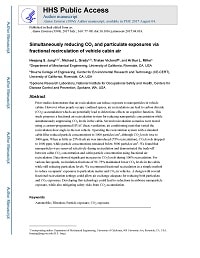Mining Publication: Simultaneously Reducing CO2 and Particulate Exposures via Fractional Recirculation of Vehicle Cabin Air
Original creation date: July 2017
Authors: HS Jung, ML Grady, T Victoroff, A Miller
Prior studies demonstrate that air recirculation can reduce exposure to nanoparticles in vehicle cabins. However when people occupy confined spaces, air recirculation can lead to carbon dioxide (CO2) accumulation which can potentially lead to deleterious effects on cognitive function. This study proposes a fractional air recirculation system for reducing nanoparticle concentration while simultaneously suppressing CO2 levels in the cabin. Several recirculation scenarios were tested using a custom-programmed HVAC (heat, ventilation, air conditioning) unit that varied the recirculation door angle in the test vehicle. Operating the recirculation system with a standard cabin filter reduced particle concentrations to 1000 particles/cm3, although CO2 levels rose to 3000 ppm. When as little as 25% fresh air was introduced (75% recirculation), CO2 levels dropped to 1000 ppm, while particle concentrations remained below 5000 particles/cm3. We found that nanoparticles were removed selectively during recirculation and demonstrated the trade-off between cabin CO2 concentration and cabin particle concentration using fractional air recirculation. Data showed significant increases in CO2 levels during 100% recirculation. For various fan speeds, recirculation fractions of 50–75% maintained lower CO2 levels in the cabin, while still reducing particulate levels. We recommend fractional recirculation as a simple method to reduce occupants’ exposures to particulate matter and CO2 in vehicles. A design with several fractional recirculation settings could allow air exchange adequate for reducing both particulate and CO2 exposures. Developing this technology could lead to reductions in airborne nanoparticle exposure, while also mitigating safety risks from CO2 accumulation.

- Aerosols Emitted in Underground Mine Air by Diesel Engine Fueled with Biodiesel
- A Computer Software Program that Estimates Air Quantity Requirements in Large Opening Stone Mines
- Diesel Exhaust Aerosol, Review of Measurement Technology
- Effect of Coal Type and Oxyfuel Combustion Parameters on Pulverised Fuel Ignition
- Effectiveness of Iron-Based Fuel Additives for Diesel Soot Control
- The Effects of Water Emulsified Fuel on Diesel Particulate Matter Concentrations in Underground Mines
- Instrumentation for Diesel Particulate Matter Emissions Research
- Mutagenicity of Diesel Exhaust Particles from an Engine with Differing Exhaust After Treatments
- Performance Comparison of Rescue Breathing Apparatus
- Technology News 514 - The Air Quantity Estimator (AQE): A New Computer Software Tool for Large-opening Mine Ventilation Planning